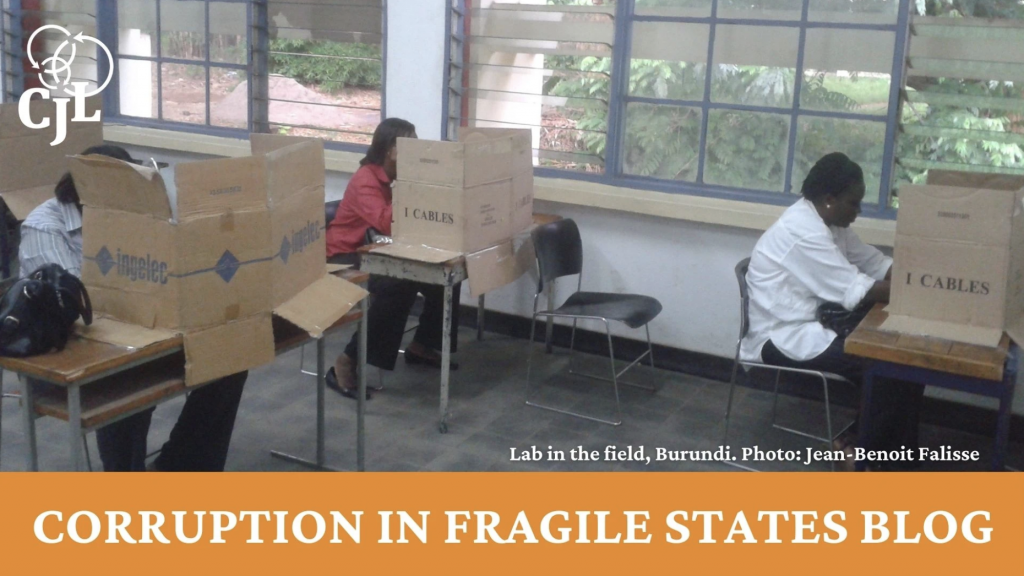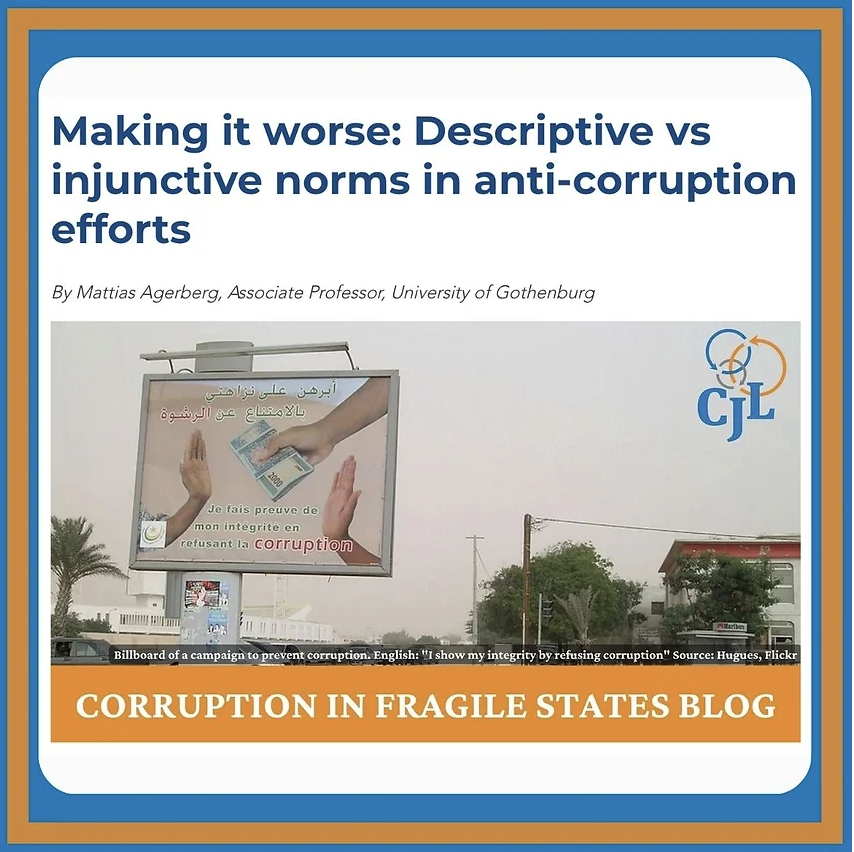When do anti-corruption messages work, and with whom?
By Jean-Benoit Falisse, Senior Lecturer, University of Edinburgh
This blog post originally appeared on the Corruption in Fragile States Blog. Subscribe here to receive blog updates via email.

Anti-corruption sensitization messages are probably the most ubiquitous of all anti-corruption tools. During anti-corruption campaigns, one can see them everywhere from prime-time TV ads, to billboards, to posters in schools and hospitals. Public servants and public service providers are a prime target: they’re urged to turn down attempted bribes and refrain from misappropriating public goods.
But do anti-corruption sensitization messages make any difference at all? It’s a legitimate question. In the last decade or so, a series of studies that cast doubt about digital advertising’s ability to affect shoppers’ behavior has shaken the advertising world, which similarly relies on raising people’s attention to a particular issue through messaging. eBay and Facebook may, in fact, have overestimated the effectiveness of their ads by up to 4,000%.
In the world of anti-corruption, many researchers have pointed out that raising awareness to corruption does not necessarily mean many changes in practice (or may even make things worse). Such reckoning, however, has yet to happen among most practitioners. But if practice needs to change, what might it look like?
Testing anti-corruption messaging in Burundi

In a recently published study, we became interested in a key dimension that may affect the effectiveness of anti-corruption messaging: the interplay between social and moral norms—what is seen as one’s normal and expected social behavior—and corruption. We built on research from different disciplines. In social anthropology, for instance, a growing body of research has stressed the importance of understanding so-called ‘practical norms’ in public service: what is it that constitutes an accepted and acceptable behavior in practice in the first place? In social psychology and behavioral economics, new evidence that moral and behavioral norms differ between social and professional groups has emerged—for instance, the seminal research by Cohn, Fehr, and Marechal showing that bankers were more likely to cheat in a lab game after the experimenter had stressed the participants’ professional identity.
In our research, we set up a lab in the field experiment in Burundi. Actual civil servants were asked to react to a scenario where citizens asked them to “provide a service they are not meant to provide against some extra money”—a bribery attempt (as they identified it in later focus groups). The stakes were real: civil servants could make actual money. Burundi was and still is one of the poorest countries on earth, and, by all available metrics, corruption is rampant.
“Beyond dangerous clichés on civil service in resource-poor environments, what do we actually know of the social and moral norms that structure daily life in the public service? For practitioners, the implication is clear: before launching a campaign, define target groups and carefully understand and document their day-to-day realities.“
Our preliminary research had found that, despite those adverse circumstances, civil servants generally viewed bribery as inconsistent with their professional values—this was especially true for teachers and court clerks, slightly less so for the police. We are far from the only ones to make that point but it bears reiteration: anti-corruption practitioners should not conflate widespread corruption with widespread acceptance of corruption.
Would anti-corruption messages make any difference? Before answering this question, we had to think carefully. Many anti-corruption messages are generic: they describe corruption as something bad, immoral, or with dire consequences.
Subscribe here to receive the Corruption in Fragile State Blog’s posts. We publish every three weeks—enough to keep you informed without cluttering your inboxes.
Anti-corruption practitioners should, however, think twice about which messages to display. Indeed, research shows that the framing of sensitization messages matters: in a lab experiment, asking participants “not to cheat” was found less effective than asking them “not to be cheaters.” The likely underlying mechanism, as the researchers explained, is that the second message speaks to one’s “implication of the self.” In societies where cheating is considered amoral, very few want to see themselves as cheaters deep inside.
In our lab in the field, we decided to expose a portion of our participants to two written anti-sensitization messages (in the national language, Kirundi): one was framed in general terms “good governance is the pillar of an equitable and uncorrupted society” and the other one appealed to professional norms “a real public servant is equitable and incorruptible.” As anticipated, only the second message had some effect on the participants’ behavior. But what is it exactly in the behavior of the participants that changed?
“Anti-corruption practitioners should not conflate widespread corruption with widespread acceptance of corruption.”
Our scenario did not imply reciprocity; civil servants could pocket the bribe without being forced to provide the service to the briber. This is precisely what happened: exposure to the message did not affect the civil servants’ propensity to take the bribe. It did, however, make them keener to deny the request of the briber and, instead, treat them as an ordinary citizen who hadn’t attempted to bribe them. Practitioners may want to think through this case, and how it compares to the situations they confront. Would they see their anti-corruption campaigns as successful if they ‘only’ made public services fairer from the perspective of users, but did not necessarily curb illicit payments? Which is most important?
Rethinking anti-corruption sensitization
These findings suggest two key action points for policymakers and anti-corruption practitioners.
1. The exact framing and wording of anti-corruption messages matters.
A message appealing to one’s “implication of the self within society” might be more effective than a broad descriptive message—this resonates with work on injunctive versus descriptive norms that Mattias Agerberg recently presented on this blog.
There is no one size fits all: crafting a good message requires a good understanding of the norms and values of the target group and brings us back to the question social anthropologists are asking: what do we know of practical norms? Beyond dangerous clichés on civil service in resource-poor environments, what do we actually know of the social and moral norms that structure daily life in the public service? For practitioners, the implication is clear: before launching a campaign, define target groups and carefully understand and document their day-to-day realities.
2. Determine the aim of anti-corruption messages.
Is it about stopping illegal monetary transactions or making public services fairer towards all? These two dimensions are tightly connected in situations where the bribee, once they accept the money, is effectively forced to provide what the briber asked for; social anthropologists and sociologists have long provided convincing depictions of such circumstances.
Our research sought to explore behaviors in the many situations where such reciprocity is not automatic. Someone may, for instance, give money (a bribe) to a policeman hoping they would write off the speeding ticket they received only to find that the policeman decides not to do so. There are also situations where the “service” asked in exchange for a bribe is loosely defined or situations where the bribee may choose only to provide part of what they were bribed for. Of course, policymakers will want to both stop illegal monetary transactions and make public services fairer; one implication of our research is that the tools to achieve each objective may need to be different.
Anti-corruption messaging campaigns are not doomed to be pointless (or even damaging) but they are not easy to get right: crafting an impactful message requires an understanding of the social and moral norms that govern day-to-day life, and how people view themselves. These elements will vary slightly, but meaningfully, between socio-professional groups. It is in that space, and highlighting one’s specific role in societal change, that better anti-corruption messages can emerge.

Jean-Benoît Falisse is a senior lecturer (associate professor) in African Studies and International Development at the University of Edinburgh. His work looks at the political economy and governance of basic social services in so-called ‘fragile’ and conflict-affected societies. He has carried out multiple evaluations with and for governmental and non-governmental organisations for the past 15 years, with his most substantial experience in the African Great Lakes region.

